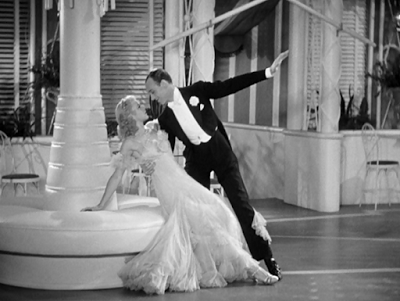Format: DVD from personal collection on rockin’ flatscreen.

There’s a particular charm to early musicals, at least in theory. Even when they aren’t very good, there’s a sweet innocence to them. When your stars are Fred Astaire and Ginger Rogers, though, you’re likely to find something worth watching even if the story is dippy. The Gay Divorcee is the second film the pair made together, and while the plot isn’t a great deal to get excited about, it’s a hard film not to enjoy. Astaire and Rogers are a great couple on screen and a better one on the dance floor. Toss in Edward Everett Horton and Betty Grable, and yo’ve got a movie that, while thin on believable plot, is hard not to enjoy.
One of the benefits of The Gay Divorcee is that it doesn’t try to do anything crazy with Astaire’s character, like make him a gambler or something ridiculous. In this case, he’s Guy Holden, a famous dancer. Guy is returning to London with his friend Egbert Fitzgerald (Edward Everett Horton). When they arrive he discovers a young woman in distress—he skirt is caught in a steamer trunk and he assists her by tearing her skirt and then giving her his raincoat to cover her. She is naturally annoyed but he is smitten with her.
Egbert, as it happens, is a lawyer, but not a very good one. He’s been asked to cover his father’s firm while he is out, but has also been instructed not to do anything. However, a divorce case falls into his lap, and the girl is Guy’s girl from London, Mimi Glossop (Ginger Rogers). Mimi is desperate to divorce her husband, a geologist whom she hasn’t seen for years. Egbert decides that the best course of action is to have her caught with another man, which will speed the divorce along. This plan is approved of by Mimi’s Aunt Hortense (Alice Brady), thrice married, a former fiancée of Egbert’s, and a complete busybody.
With Guy still pining for Mimi, he and Egbert head down to a resort, which is also where Egbert plans to have Mimi caught sort of in flagrante with an Italian pseudo-gigolo named Tonetti (Erik Rhodes). Of course signals get crossed and Mimi becomes convinced that she’s supposed to get caught with Guy, Guy wonders why Mimi is alternately interested in him and repelled by him, and there’s lots of dancing before we get to a happy ending with Mimi’s dignity intact.
Like I said at the top, The Gay Divorcee is pretty thin on plot. It’s standard fare for early musicals in that sense, because this isn’t a film about plot. This is an opportunity for people mired in the Great Depression to see some pretty people in nice clothes dancing and singing and taking their minds off their troubles for a couple of hours. The plot isn’t important at all—it’s a platform to get Fred and Ginger onto a dance floor a couple of times and to have Edward Everett Horton do double-takes better than anyone in film history. We’re not expected to take this seriously because it’s not serious at all.
It’s all about the dancing and the romance between Fred and Ginger…er, Guy and Mimi that we know is going to happen. The plot is merely a device needed to get the two of them together, and once they’re together, we’re just waiting for them to dance. Of course, they do, and it’s a great thing to behold. There’s nothing like them, and won’t be again. There’s a joy in watching them work a dance floor that can’t really be compared to anything else.
While this is a trifle, I get why it was nominated for Best Picture. There’s certainly nothing objectionable here, and I can imagine that anyone watching this in 1934 would be easily and temporarily transported away from their worries. Oh, the performances aren’t great outside of the dancing, but they’re good and no one really played a sap like Edward Everett Horton. He even gets his own dance number with Betty Grable. Sort of. She dances, he just looks goofy, because that’s what he did well.
So let’s talk dancing. One of the great things about these old Astaire/Rogers films is how much of the dancing shows the whole bodies of the dancers and how much is done in a long take. There aren’t a bunch of quick cuts to mask that these people aren’t talented. Instead, we’re shown everything in glorious detail to demonstrate just how damn talented they were. If anything, there’s not enough dancing here.
Yeah, it’s silly. Yeah, the plot is a goof. So what? You won’t care. I didn’t.
Why to watch The Gay Divorcee: It’s Fred and Ginger. What more do you want?
Why not to watch: Like most of the films in this style, it’s a trifle.
